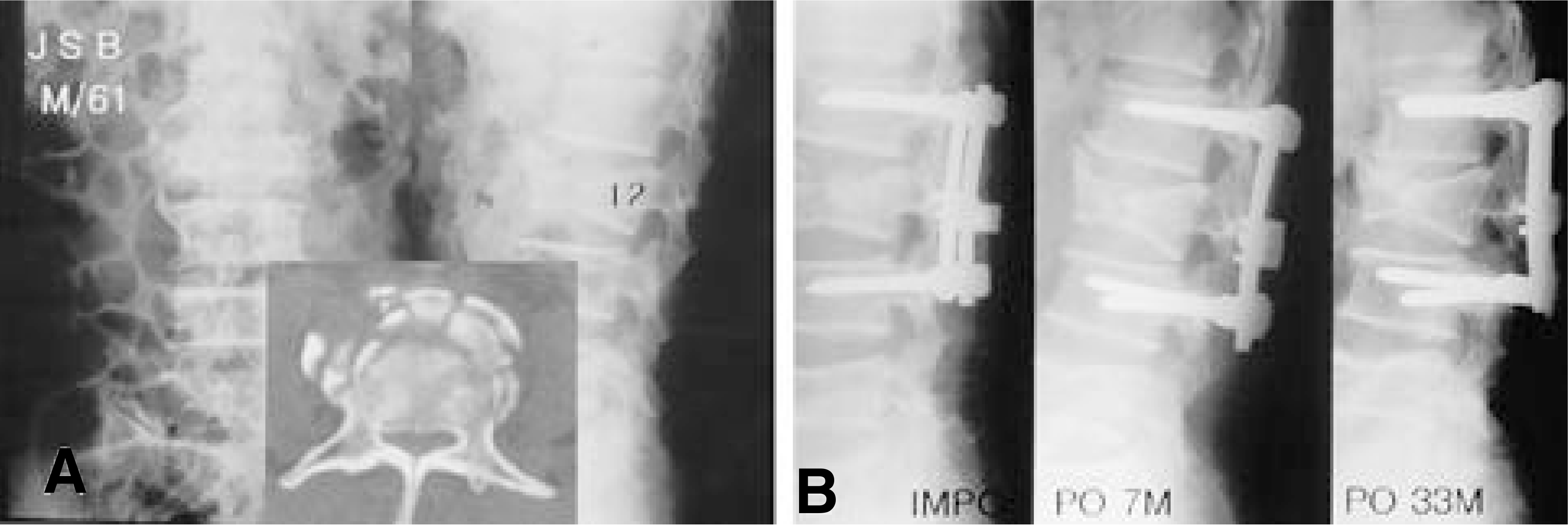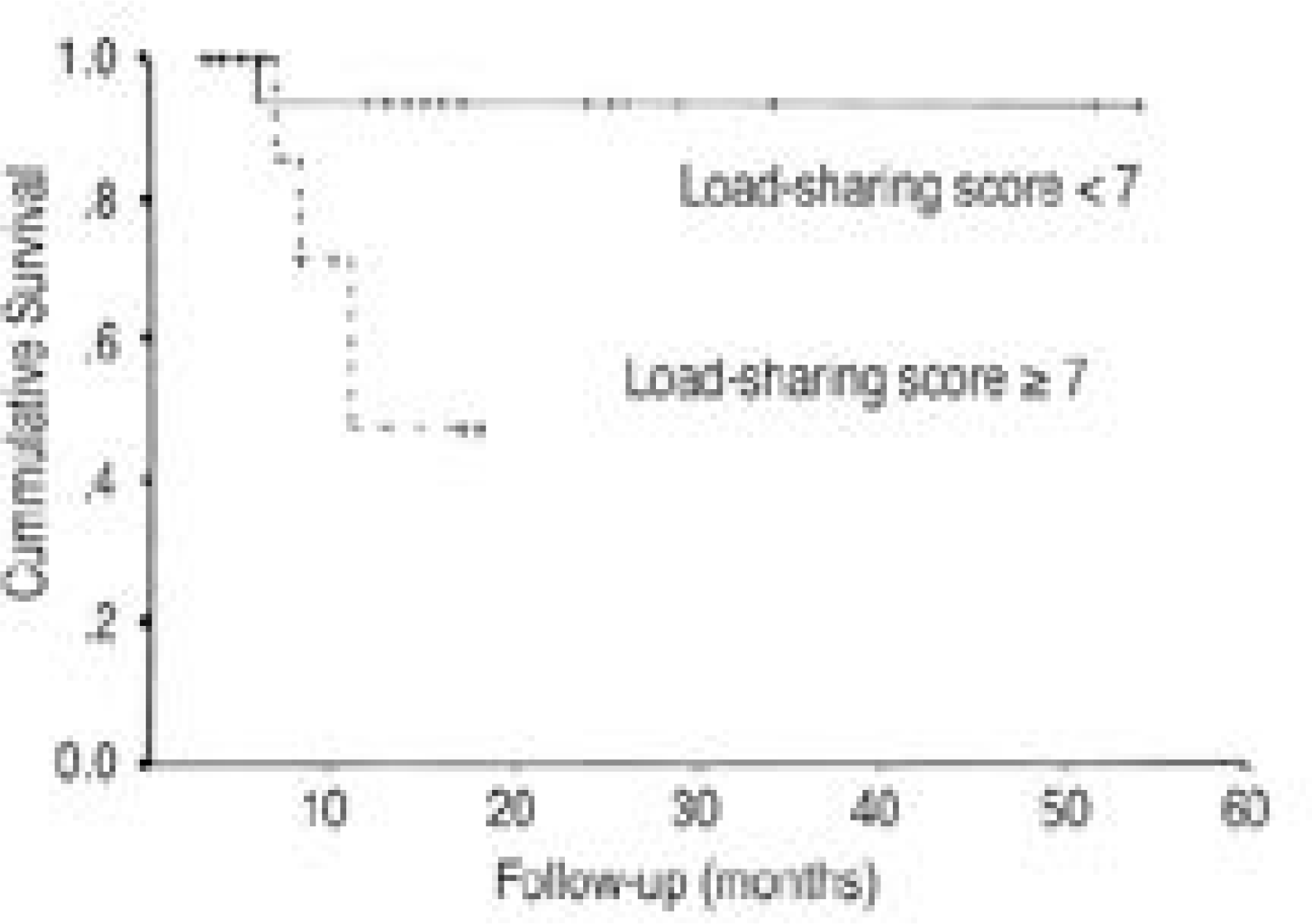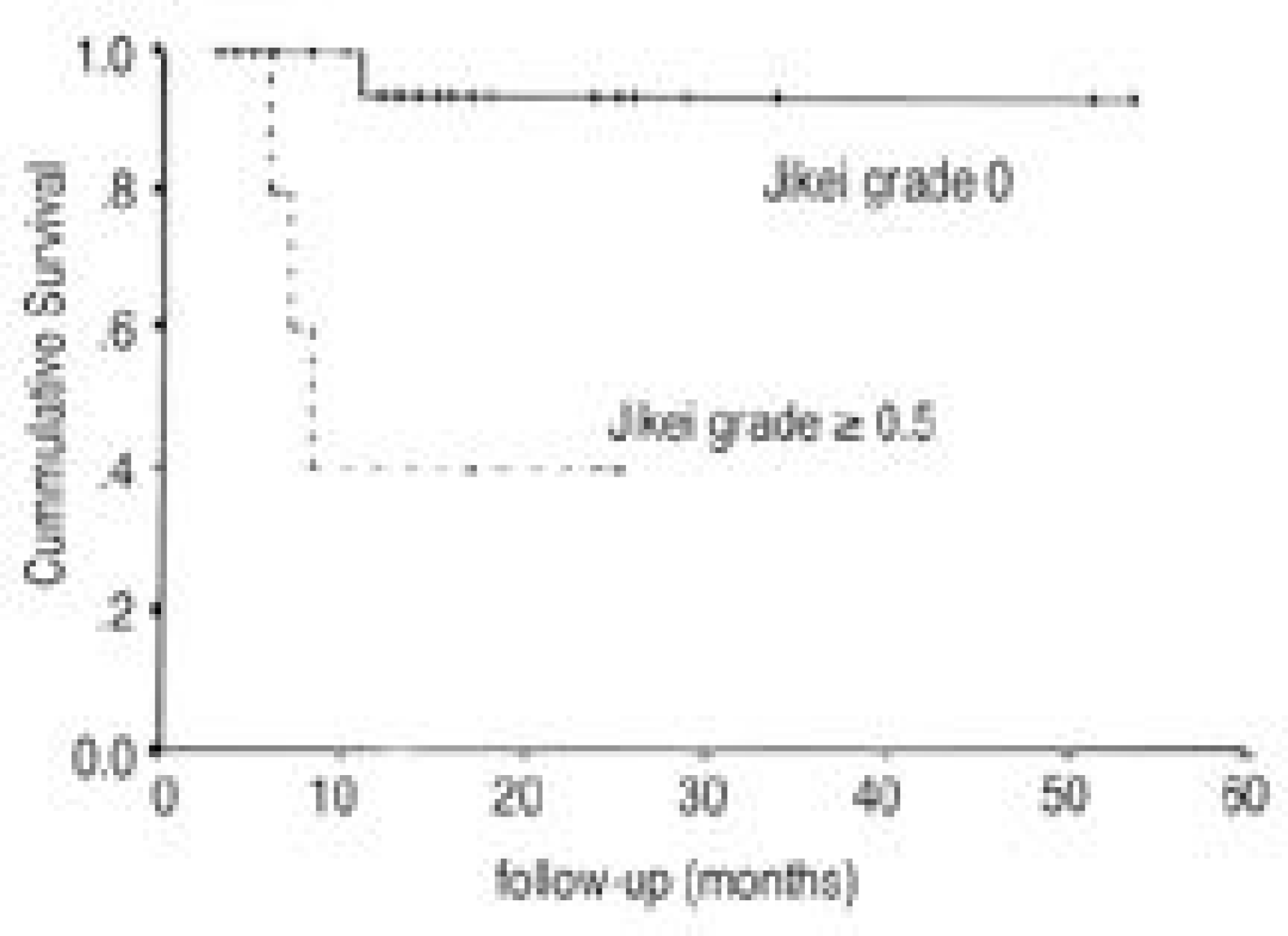Abstract
Objectives
To evaluate the fixation survival rate and the radiologic prognostic factors of posterior short fusion in thoracolumbar fracture.
Summary of background data
Posterior short fusion has the advantage of saving motion segments in spite of high fixation failure rate. The high Load-Sharing score is well known as a cause of fixation failure, but the effect of osteopenia is not evaluated.
Materials and Methods
A uthors evaluated 27 patients treated surgically with posterior short fusion using pedicle screws as thoracolumbar fractures from 1995 to 1999. The median followup was 20.5 months (6- 54). The survivorship using Kaplan-Meier method and the radiologic prognostic factors were evaluated.
Results
The sagittal index was preoperatively 16.7°(± 7.9 SD), immediate postoperatively 6.9°(± 4.6), and at last followup 10.6°(± 6.9). The fixation failures were detected in 4 patients, and the failure time was ranged from 6 months to 11(median 7.5). The overall survival rate was 82.3% at the last followup. The significant prognostic variables were Load-Sharing score, Jikei grade, compression percent and age in uni- variate analysis, but the Load-Sharing score and Jikei grade were significant prognostic factors in multi- variate analysis.
Go to : 
REFERENCES
1). Bradford DF, McBride GG. Surgical management of thoracolumbar spine fractures with incomplete neurologic deficits. Clin Orthop. 218:210–216. 1987.

2). Carl AL, Tromanhauser SG, Roger DJ. Pedicle screw instrumentation for thoracolumbar burst fractures and fracture-dislocation. Spine. 17(8S):s317–s324. 1992.
3). Dean JR, Ison KT, Gishen P. The strengthening effect of percutaneous vertebroplasty. Clin Radiol. 55:471–6. 2000.

4). Dvorak MF, Fisher CG. Revision spine surgery in the presence of osteoporosis. (in. Margulies JY, Aebi M, Farcy JP, editors. Revision spine surgery. 1st ed.Philadelphia: Mosby;p. 646. 1999. .).
5). Ebelke DK, Asher MA, Neff JR. S u r vivorshi p analysis of VSP spine instrumentation in the treatment of thoracolumbar and lumbar burst fractures. Spine. 16(8s):s428–432. 1991.
6). Fan KF, Tu YK, Hsu , Robert WW. Using the load sharing score to predict fixation failure of thoracolumbar burst fracture. abstract book, 12th WPOA. 1998.
7). Farcy JPC, Weidenbaum M, Galssman SD. Sagittal index in management of thoracolubar burst fracture. Spine. 15:958–965. 1990.
8). Graziano PG. Cotrel-Dubousset hook and screw combination for spine fractures. J Spinal Disord. 6:380–385. 1993.

9). Huler RJ. Thoracolumbar Spine Fracture. (in. John W. Frmoyer, editor. The adult spine-principles and practice. 2nd ed.Philadelphia: Lippincott-Raven;p. 1473. 1997.

10). Katonis PG, Kontakis GM, Loupasis GA, Aligizakis AC, Christoforakis JI, Veilvassakis EG. Treatment of unstable thoracolumbar and lumbar spine injuries using Cotrel-Dubousset instrumentation. Spine. 24:2352–2357. 1999.

11). Karaikovic EE, Gaines RW. Load-sharing classifi -cation-preventing implant failure following surgical treatment. (in. Margulies JY, Aebi M, Farcy JP, editors. Revision spine surgery, 1st ed. Philadelphia: Mosby;p. 354. 1999. .).
12). McCormack T, Karaikovic E, Gaines RW. Th e load sharing classification of spine fractures. Spine. 19:1741–1744. 1994.
13). McLain RF, Sparling E, Benson DR. Early failure of short segment pedicle instrumentation for thoracolumbar fractures. J Bone Joint Surg. 75:162–167. 1993.
14). Oleksik A, Ott SM, Vedi S. Bone structure in patients with low bone mineral density with or without vertebral fractures. J Bone Miner Res. 15:1368–1375. 2000; Successful short-segment instrumentation and fusion for thoracolumbar spine fractures: a consecutive 4 and 1/2year series. Spine,. 25:1157–1170. 2000.

16). Soshi S, Shiba R, Kondo H, Murota K. An experimental study on transpedicular screw fixation in relation to osteoporosis of the lumbar spine. Spine. 16:1335–1341. 1991.

17). Vanderschot P, Caluwe G, Lauteur L. The use of hybrid allograft in the treatment of fractures of the thoracolumbar spine. Eur Spine. 10:64–68. 2001.
18). Weinstein JN, Collalto P, Lehmann TR. Thora -columbar burst fractures treatment conservatively - A long term follow up. Spine. 13:33–38. 1988.
Go to : 
Figures and Tables%
 | Fig. 1-A.Preoperative radiographs of 61 years-old male showed L2 stable burstfracture with more than 40% compression, load-sharing score 8 point and Jikei grade 1. Fig. 1-B. Immediate postoperative, 7 and 33 months followup lateral radiographs showed acceptable correction and fixation failure, but radiologic bone union. |
 | Fig. 2.The fixation survival rates according to load-sharing scores. The survival rate of less than 7 score was higher than 7 or more score (p<0.05). |
 | Fig. 3.The fixation survival rates according to Jikei grades. Jikei grade 0.5 or more showed significantly lower survival rate (p<0.05). |
Table 1.
Jikei grading scale
Table 2.
Summary of sagittal parameters at perioperative and last followup
| Parameters | preoperative | immediate pop∗ | last followup |
|---|---|---|---|
| Sagittal index (°) | 16.7 | 96.9 | 10.6 |
| Fused angle (°) | 18.6 | 97.9 | 12.3 |
| Vertebral compression % | 38.5 | 19.5 | 23.7 |
Table 3.
The survivorships of statistically non-significant factors




 PDF
PDF ePub
ePub Citation
Citation Print
Print


 XML Download
XML Download